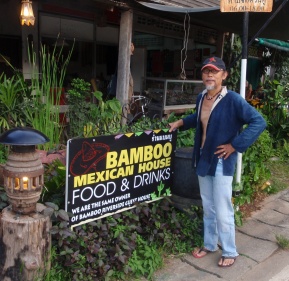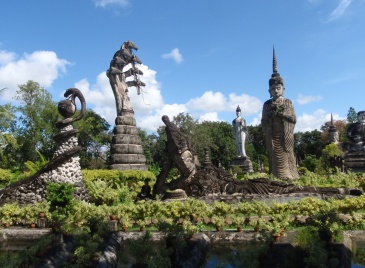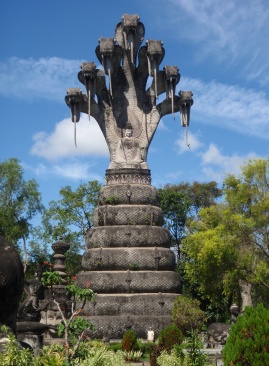THAILAND BY LAND
This travel was relatively ‘low key’ for us. We left Phuket with air tickets to Bangkok and train tickets to Chiang Mai. We also knew where we would stay (at least for our first night) in Chiang Mai. Otherwise, we were without an itinerary – much less reservations. We wanted to move at our own pace to places that interested us as we traveled.
We traveled with backpacks, and we took almost all local transportation. We stayed in guesthouses with our only criteria being that our room have a toilet (although not always the flushing variety) and a shower (although not always the hot water variety). Most of our food came from local hawker stalls. And we really enjoyed traveling like this without schedules.
We flew from Phuket to Bangkok on Air Asia which is a budget airline with many restrictions and few frills (they charge you for a drink of water). However, they are a blessing to those of us whose travel budgets are always in the red. Flying in to Bangkok mid-day was interesting because of what we did not see – birds. Bangkok is essentially a wetlands, but it is devoid of birds. We did not see any.
We took the Airport Express bus across town to the train station during the afternoon rush hour. Yes, Bangkok has moderately heavy traffic, but we are hard to impress after visiting Hanoi. We were glad that we were not driving (driving in Thailand is miserable), but it was not nearly as bad as we expected.
We went to Bangkok’s main train station – Hualamphong – to catch our overnight train to Chiang Mai. The touts nearly led us astray before we even got in the station, but we figured out where we needed to go and walked away. We were directed to our train by a helpful English-speaking local. We were greeted at the train by a uniformed man whose title and job description remain unknown to us. He did nearly everything that needed to be done in our car – check tickets, haul luggage, deliver drinking water, make bunks, etc. He officiously showed us to our cabin.
We had purchased the highest level of cabin/service available, but our cabin was a bit of a disappointment. It was small, but we expected that. We did not, however, expect it to be as dirty as it was. We made sport out of whacking cockroaches. There was not a dining car, and we had not packed food, so we ordered dinner from a limited menu of local foods. The food tasted ok, but the oil content was overwhelming as was the price when we got our bill the next morning. But we crawled in to our sleeper berths with full bellies and anticipation of arriving in Chiang Mai the following morning.
Bud slept intermittently, but sleep did not come to Nita all night. The tracks were very rough and, therefore, noisy. At times it was a bit unnerving with both of us worrying if the train would remain on the tracks. But it did, and we arrived in Chiang Mai in the morning after an expensive and inedible breakfast.

Clay sculptures ready for paint
We had received a recommendation to stay at the Golden Triangle Inn in Chiang Rai, so we went there. We were quite disappointed in our room. It was dirty and in poor repair. We also had obnoxiously noisy neighbors. We roamed around town a bit, but we did not find much of interest.
We checked out of the Golden Triangle Inn in the morning and moved to the Moon and Sun Hotel which was nearly an opposite of the Golden Triangle Inn. Moon and Sun Hotel was clean, it had air conditioning and cable television, but it lacked personality. But that was ok – we had had enough personality the prior night.
We decided that we would move on to another town after one more trip to town. We had heard a few small bits about the Hill tribe Museum and Education Center in Chiang Rai, and we wanted to visit there before leaving town. We nearly did not find the museum/center because it is small without any obvious sign, but we were glad that we did find it. This is where we met Jerry.
Jerry is Belgium’s Count Gerald van der Straten Ponthoz. Yes, he is titled. Yes, he is well off. And yes, he chooses to live in Chiang Rai, Thailand and work with children from the local hill tribes. Interestingly, Jerry is also related to Thai royalty (King Chulalongkorn Rama V). However, it is his family’s businesses in Belgium that enable him to pursue this labor of love.

Huge golden Buddha
We roamed around town a bit, and we did not see another farang (foreigner). We also found no English, but we have learned to communicate the basics without a common language. We came across a woman building a wood-fired barbecue in half of a 55 gallon drum. She had a tub full of large squid – ranging from 12 to 16 inches in length – that we could not resist. She gave us a small amount of a ‘dipping sauce’ to go with our monster squid, and they were delicious! We wished we had the language skills to tell her just how good they were.
There was little to do around Chiang Saen, so we decided to travel to the Hall of Opium Museum the next day. We rented a motorbike, and we failed to notice its fuel gauge before we left town, but we luckily found a roadside stand selling fuel before running out.

The Golden Triangle – the meeting of Thailand, Laos, & Myanmar
We stopped about five miles north in the small town of Sop Ruak which is at the center of the Golden Triangle area. It is at the confluence of the Nam Ruak and Mekong Rivers, and you see both Myanmar and Laos across the rivers. We had a good lunch along the riverside, and we took a few pictures of the huge golden Buddha before moving on to the Hall of Opium.
The Hall of Opium, another five miles north, is more than 60 thousand square feet of building situated on 100 acres of beautiful land. We were initially impressed with the building, the site, and the welcome we received. However, we became increasingly disillusioned as we progressed through the self-guided tour. We learned very little about opium and its role in the surrounding communities (it still has a substantial role in local economies). Instead, we viewed and listened to non-stop hysteria over the evils of opium. We were very disappointed.
We returned to Chiang Saen and went for more monster squid. We had a quiet night (we think all nights in Chiang Saen are probably quiet), and we made plans to move on to Chiang Khong the following day.

Mexican food here?
Chiang Khong has only 8,000 to 9,000 residents; however, many of the local hill tribes come in to town for trade. Many in those hill tribes – mostly Mien and White Hmong – fled Laos during the communist takeover in 1975, and they are suspected by many to be planning organized resistance against the current Lao government. They are, however, welcome in and around Chiang Khong. Partly because of the local hill tribe population and partly because of the border crossing in to Laos, Chiang Khong is a livelier town than Chiang Saen even though it is more remote.
When we got off the truck/bus in Chiang Khong, we were greeted by a particularly lively and friendly man who spoke very good English. He told us that he previously ran the Bamboo Riverside Guest House, but it is closed down. He still, however, runs the Bamboo Mexican House restaurant, and he invited us to come for dinner. A Mexican restaurant here? This seemed very odd, but he was so friendly that we looked forward to returning later to talk more with him.
In the meantime, we needed a place to stay. The first two guesthouses we tried were full, and we were directed to Reuan Thai Sophaphan which had rooms available. This was one of the more colorful places we stayed. This is a massive teak building that has been divided and subdivided over the years. Most of the interior walls are simply woven mats hanging from overhead, so privacy and security are on a different level. But the owner/manager, Sophaphan, spoke some English, and she was a very interesting character to talk with.
We roamed around town a bit, and we stopped at the Easy Bar and Restaurant because they claimed to show movies nightly. We had our first lousy food on this trip here, and they did not show a movie. It was starting to rain, so we returned to our humble abode just before the skies opened and it poured.
We went for breakfast at the Bamboo Mexican House, and it was excellent. We had the best coffee we had drank since leaving home. We also had fresh fruit with homemade muesli and yogurt – delicious! Jib – the owner/manager of the Bamboo – told us that local hill tribes were coming to town this day to sell/trade their wares, so we planned a morning around the local market.
As usual, we enjoyed the market. It was muddy and messy from the prior night’s rains, but we were able to get around. We enjoyed seeing the local people as much as their wares. Some of the hill tribe people were colorful, but we were not comfortable taking their pictures without permission, so we got few pics of them. We bought very little, and we set off to investigate the ferry that we would take the next day across the Mekong River to Huay Xai, Laos.
We went to the Bamboo for dinner that night, and we could not believe we were eating Mexican food where we were – a border town on the Mekong River. We also enjoyed the company of Jib and his lovely wife, Taew. But the rain started again, so we returned to our room relatively early and packed for our short trip across the river the next morning.
We had another excellent breakfast at the Bamboo in the morning. After breakfast, Jib took us on a walkabout including his home that he recently built. It was a local’s view of the town, and we really enjoyed our time with him. But it was time to bid Thailand laa kawn for a while and start our exploration of Laos.
On October 25, with our Thai visas about to expire, we boarded a local ferry – a small longtail – and headed across the Mekong River to Huay Xal, Laos. We traveled in Laos from October 25 to November 5 when we returned to Thailand as described below.
We had been away longer than we had thought we would be, and we were ready to head back to Phuket to get back to work on Passage. Therefore, we spent only two days and one night in Nong Khai before taking another overnight train back to Bangkok then a brief flight from Bangkok back to Phuket.

Concrete Sculptures
Nita was feeling a bit worse the next day, so we planned to head ‘home’ (home is wherever Passage is – currently Phuket) that day. We wanted to give the train another try despite our previous lousy experience, so we booked ourselves to take the overnight train that night from Nong Khai to Bangkok. It left Nong Khai in the early evening, so we had a day to explore a bit. We returned to the market and bought a few small things, but our surprise adventure was out to Sala Kaew Ku Sculpture Park.

Look at Bud at base of sculpture for scale. These sculptures are huge!
We went out to this park just to kill time until we caught our train, and our expectations were low. What a surprise! This park is a collection of huge bizarre concrete sculptures depicting the artist’s unique blend of Hinduism and Buddhism. These sculptures were done over 20 years under the direction of Luang Pu Boun Leua Sourirat – a 20th century mystic shaman. Our favorite was a concrete naga that was more than 80 feet tall, but the entire park is surreal.
We were glad that we experienced the park because we were otherwise unimpressed with Nong Khai. It is the first and only place we have been in Thailand where we felt the need to watch our wallets. We recognize that many Thais make their living in the tourism industry, and we don’t mind spending our money with them. However, we felt as though we were being taken advantage of in Nong Khai – a feeling we had not previously experienced in Thailand. Fortunately this is an exception rather than the rule.
But it was finally time to take our train back to Bangkok. We noticed a uniformed man with a gun and some kind of electronic wand roaming around the train before we boarded, and we did not think much of it. However, later in the evening, while underway, this same man came to our cabin and waved his wand around for a few minutes. We don’t know what it was about, but it was a bit strange. We had learned to buy food and drinks to take with us, so we ate well. And the tracks were much smoother than our trip from Bangkok to Chiang Mai, so we also slept well. This train was no cleaner than our prior train, but it was much more comfortable, and we enjoyed it overall.
We arrived back at Bangkok’s Hualamphong Station in the early morning, and we caught the Airport Express bus back across town – this time during the morning rush hour – to the airport. We caught a 90 minute flight from Bangkok back to Phuket, and we were back home by early afternoon on November 7, 2008.
The more we see of Thailand, the more we want to see. We really enjoy almost everything about Thailand – the people, food, culture, etc. The only thing we don’t like about Thailand is the driving, so we drive as little as possible. Otherwise, we love this place, and we are having a very good time here!
Go to our Laos page, our land travel page, or our Thailand page.